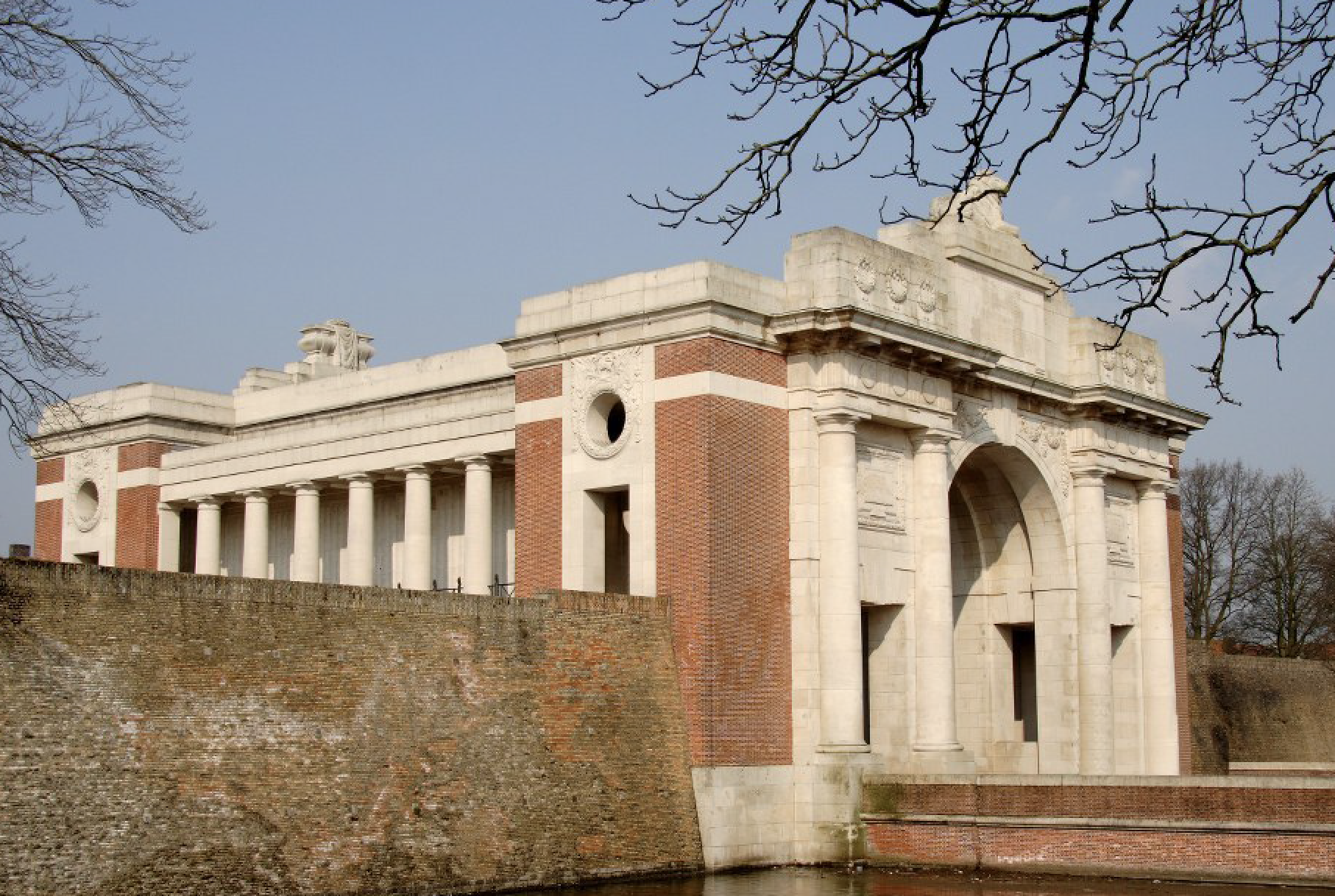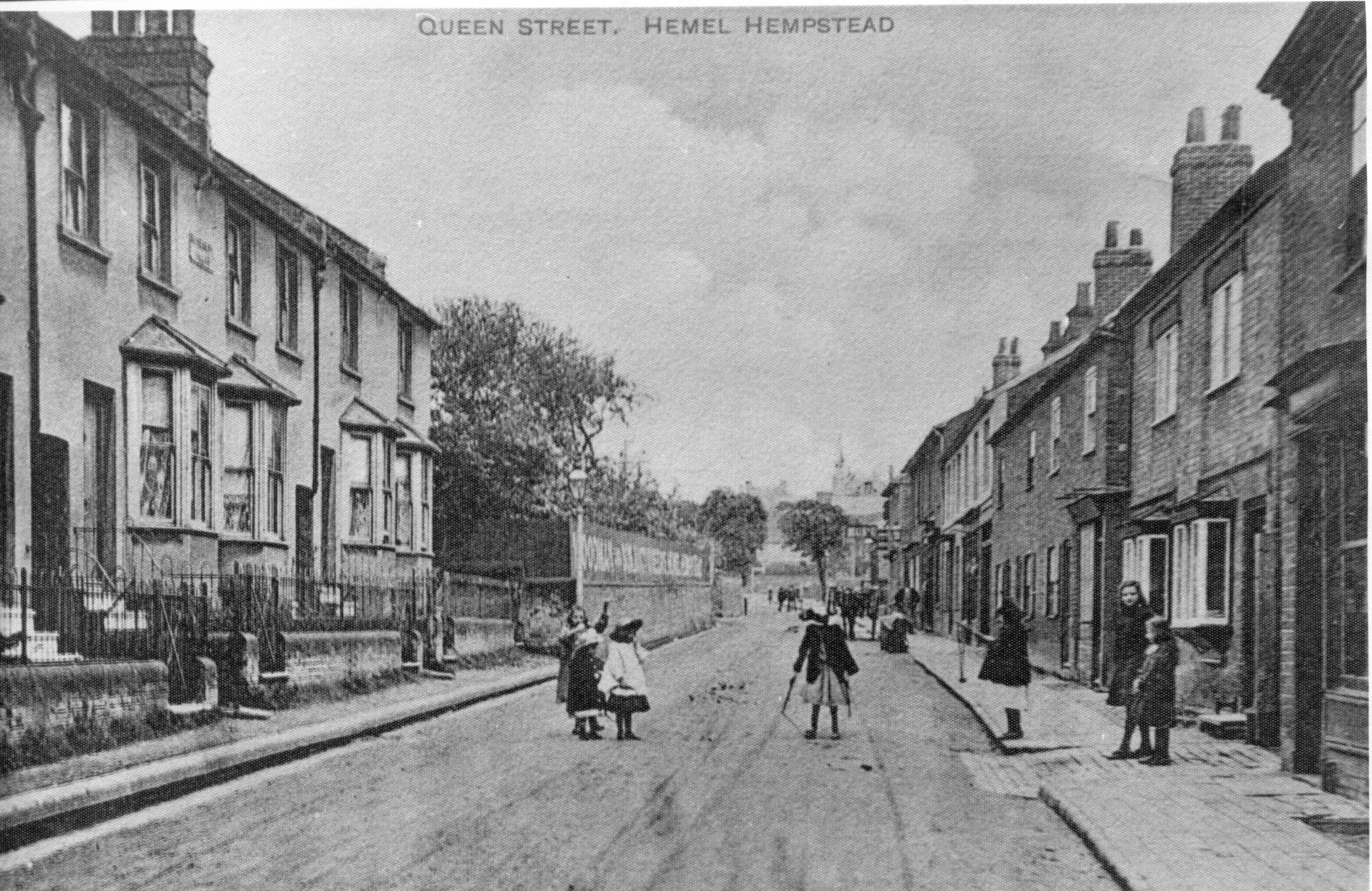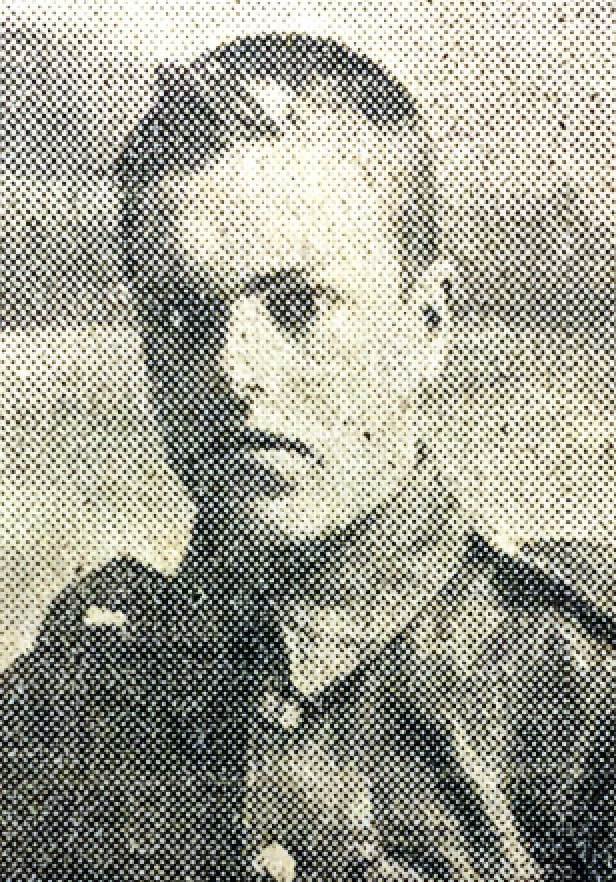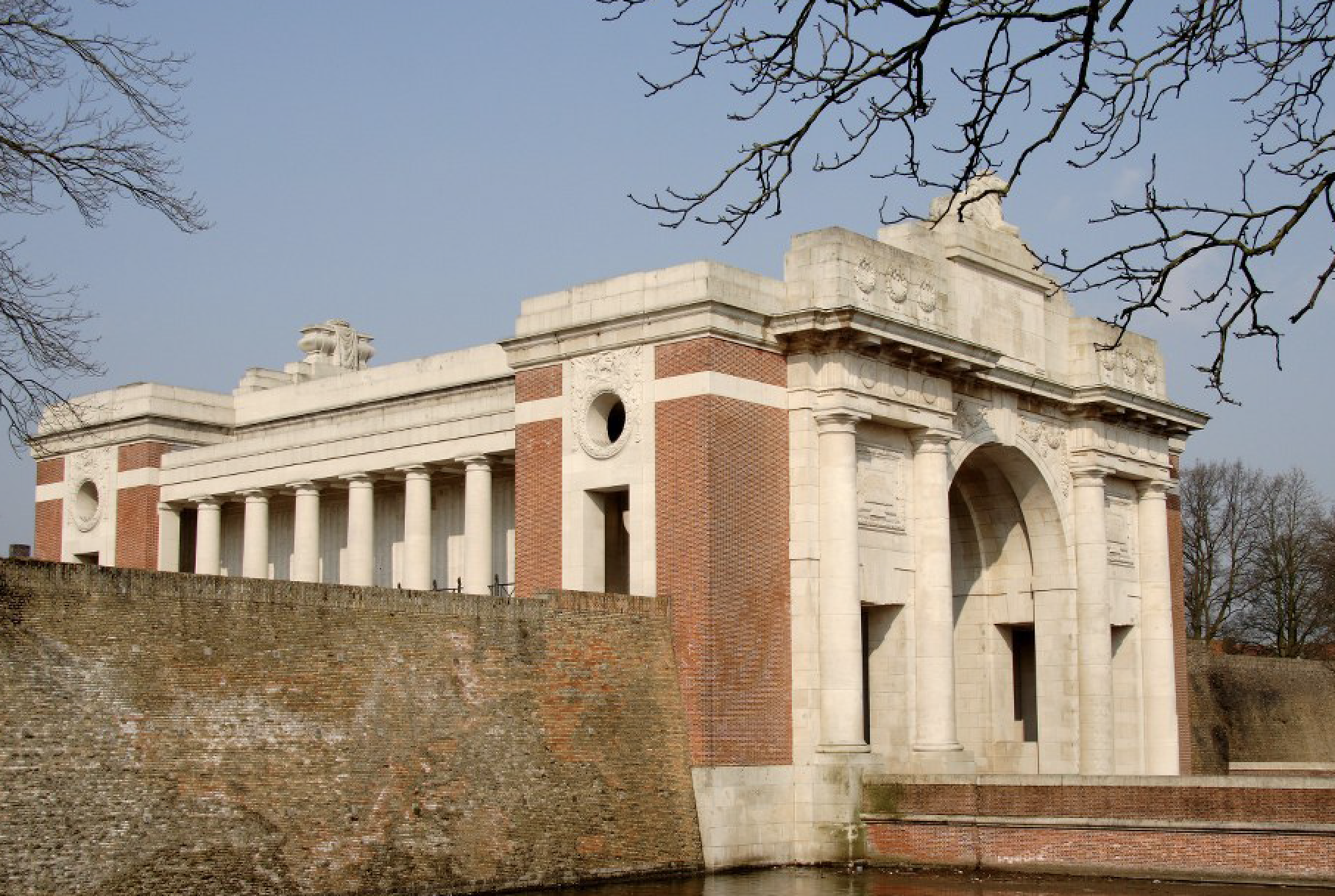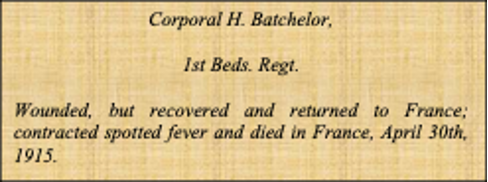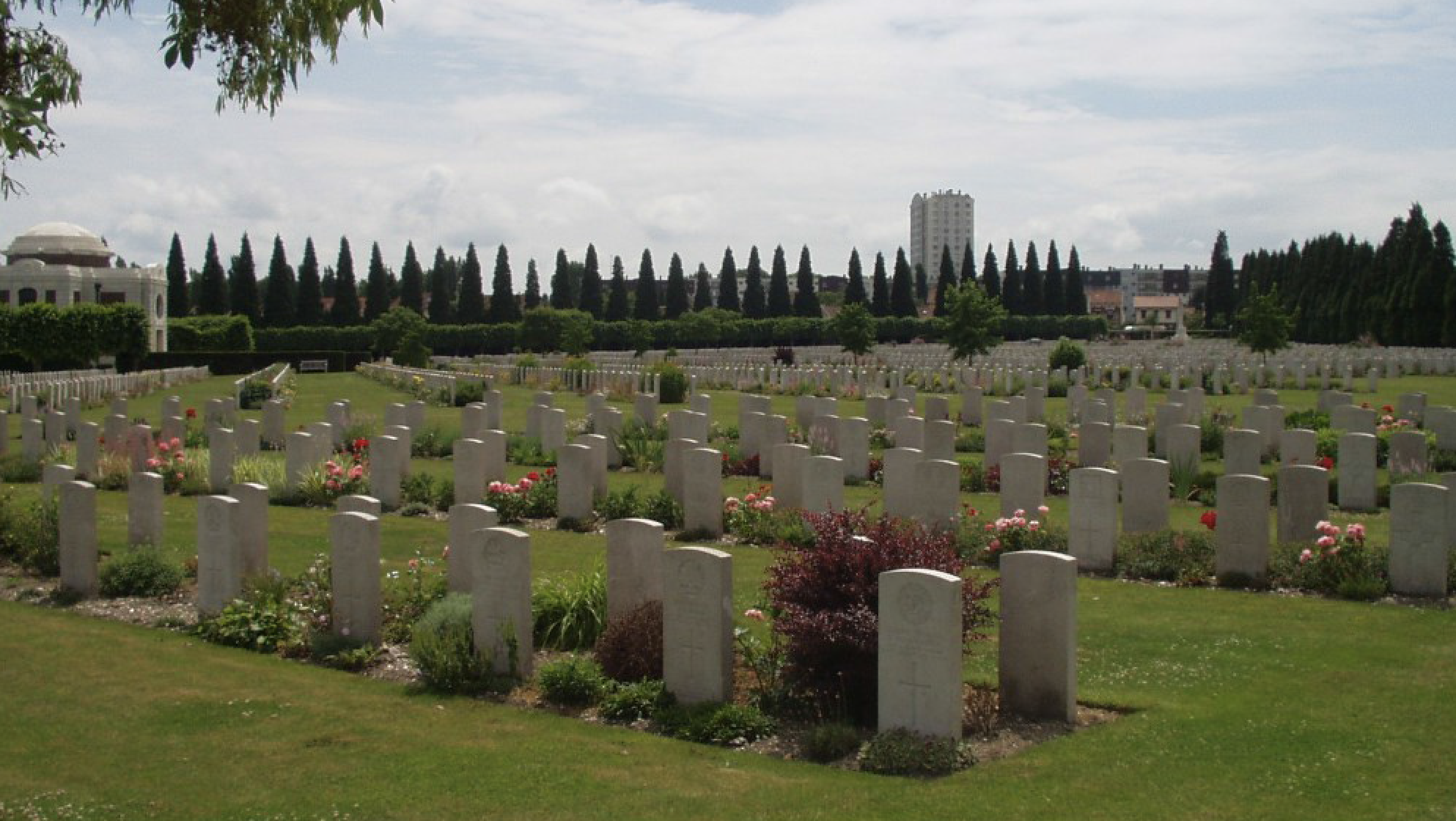Fallen in April 1915:
Frederick Joseph Thomas Johnson
Joseph Walter Sear
Frederick James Sharp
William John Miller
William Thomas Smith
Harold Batchelor
FREDERICK JOSEPH THOMAS JOHNSON
14478 Private
1st Bn., Bedfordshire Regiment
Killed in Action Friday, 16th April 1915
Remembered with Honour, Ypres (Menin Gate) Memorial, West Vlaanderen, Belgium, Panel 31 and 33
Known as ‘Fred’ to family and friends, Frederick Joseph Thomas Johnson was born in early 1895 in Little Tring to Frederick Charles and Annie Elizabeth Gregory. Elizabeth was Frederick’s second wife and they had married in 1892 in Tring. Along with two daughters from his previous marriage, Frederick and Elizabeth eventually had seven children together. Young Fred’s half-sisters were Florence Elizabeth and Ethel May. Then came an older sister Daisy and five younger siblings; Annie, Rose, William, Alfred and Dennis
In 1901 the family were living at 58 Main Road (now Vicarage Road) in Marsworth just north of Tring and Fred’s father was working as a ‘Navvy’, a physically demanding occupation and one which was dying out following the canal and railway building mania of the previous 150 years.
By 1911, sixteen-year old Fred was living and working in Marsworth as a Farm Labourer. Research suggests that Fred moved shortly after 1911 to Bennett’s End near Leverstock Green to live with his Great Uncle George Gill (Grandmother’s younger brother) who worked in the local brickworks. Soon after this move Fred found employment in the Envelope Department at John Dickinsons.
He attested at Hemel Hempstead between 31st August and 3rd September 1914 as reported in the Hemel Gazette on 5th Sept and was listed as F.J.T. Johnson. In September 1916 he is again mentioned in the Gazette, this time as F. Johnson, with a list of all the Dickinson employees who had joined the colours to that point.
By the time of Fred’s enlistment, the 1st Bn. Bedfordshire Regiment was already part of the BEF. It had seen significant action in France at Mons, Le Cateau, the Battles of the Marne and the Aisne, before being rushed north to Flanders where it fought in the Battle of La Bassee, followed by the First Battle of Ypres. By the end of November, the division had suffered 5,000 casualties and stayed in a purely defensive role that winter.
Between August 1914 and February 1915 Fred went through basic training as a new recruit and eventually disembarked in France on the 2nd February 1915 before joining ‘D’ Company in the trenches near Ypres on 19th February.
Over the next two months, Fred saw action in the trenches south of Ypres and by the beginning of April he was with the Battalion ‘in reserve’ before moving up the line to Hill 60.
The 1st Beds War Diaries record:
"11 Apr 1915 - trenches opposite Hill 60 Battn took over trenches 38 to 45 opposite Hill 60."
This was during the prelude to the British 5th Division attack on Hill 60 on the 17th April 1915.
"12-16 Apr 1915 Battn in trenches. Work carried out day & night in reconnoitring old disused French & German trenches & in opening up communication trenches, preparing dugouts etc. to shelter extra Battns about to be brought up for attack on Hill 60."
The attack on Hill 60 was the first British operation of its kind. Beginning in early March three tunnels were initiated towards the German line, about 50 yards away and by the time the work was finished, the tunnels stretched more than 100 yards. Royal Engineer tunnelling companies had laid six mines by the 10th April containing almost 10,000lbs (4,500kgs) of high explosives and 500lbs (230kgs) of guncotton (a low-order explosive). Aerial photography revealed German gun emplacements and entrenchments and on the 16th April, British artillery was ranged by air observers onto the approaches to Hill 60, ready for the attack.
It was during these preparations that Fred was killed on Friday, 16th April 1915 although there are no details of how his death occurred.
He is Remembered with Honour on the Ypres (Menin Gate) Memorial, West Vlaanderen, Belgium, Panel 31 and 33
Fred is also commemorated on the memorial for John Dickinson and Co. in Apsley
He is also Remembered on the Leverstock
Green War Memorial and mentioned at the
dedication service led by Lt. Colonel Lovel Smeathman on Saturday, 9th April 1921. Details of the service were published in the following week's Hemel Gazette. (see extract)
Fred was only 20 years old when he died.
He was eligible for the 1914-15 Star, the British War Medal and the Allied Victory Medal.
Ypres (Menin Gate) Memorial, West Vlaanderen, Belgium (Courtesy: CWGC)
John Dickinson & Co. Limited War Memorial, Apsley End (Photo: Traquair Photography, 30th Aug. 2016)
Leverstock Green village War Memorial (Courtesy: Traquair Photography 14th Feb. 2018)
Lieutenant Colonel Lovel Smeathman unveiling the Leverstock Green War Memorial, 9th April 1921 (Courtesy Leverstock Green Chronicle www.lgchronicle.net/warmem.html
Extract from the Hertfordshire, Hemel Hempstead Gazette and West Herts Advertiser 16th April 1921
JOSEPH WALTER SEAR
13556 Private
1st Bn., Bedfordshire Regiment
Killed in Action Tuesday, 20th April 1915
Remembered with Honour, Poperinghe Old Military Cemetery, West Vlaanderen, Belgium, Plot: II. N. 8.
Joseph Walter Sear was born in Hemel Hempstead in May 1886 the first child of William and Lizzie Jane Hutton. William was a Bricklayer and Lizzie a laundress and they lived at 40 Queen Street (today Queensway) when Joe was born. In 1901 Joe was still living with the family at the same address and working as a Confectioner’s Errand Boy. His mother was still working as a Laundress, but his father has changed occupation and is listed as a Miller’s Carter.
Joe had acquired four younger siblings by 1901 which increased to seven by the 1911 Census. His parents had been married for twenty-four years by the time of this return and they had a total of seventeen children, nine of whom had sadly died young. Joe’s living siblings, all younger, where; Lizzie Jane, Mary, Harry, Emily (Emma), George, Kate and Rose. Joe and two of his sisters, Lizzie Jane and Dorothy Rose were baptized together at St Mary’s Church in 1889, but Dorothy Rose died a year later. It appears that the youngest surviving child Rose was named for her dead sister.
Joe and his father William were both working as General Labourers on the outbreak of war and the family where by that time living at 145 Marlowes in Hemel Hempstead.
Joe attested at Hertford with the 1st Battalion Bedfordshire Regiment in late August 1914 and following his basic training disembarked in France on 2nd February 1915. By 11th April the Battalion took over trenches 38 to 45 opposite Hill 60 and were engaged in the battle to take the hill six days later.
On the 17th April the first pair of mines, previously laid by the Royal Engineers, were blown and the rest ten seconds later. Debris was flung almost 300ft (91 m) into the air and scattered for 300yds (270 m) in all directions, causing some casualties to the attacking battalions of the 13th Brigade. Virtually the whole platoon of Saxon Infantry Regiment 105 in the front line was destroyed and the survivors were overwhelmed. The British took the Hill for the loss of only seven casualties.
However, the story over subsequent
days was very different as the Germans mounted intensive attacks to retake the
Hill. On the 19th and 20th April they maintained heavy “annihilation
bombardments” of the hill and by the 21st April the hill had become
a moonscape of overlapping shell-holes and mine craters.
The Battalion War Diaries record the 1st Bedfordshire’s situation on the 20th April; ‘Enemy counter attacked: tremendous bombardment carried out against Hill 60, & our trenches & supports. Enemy's heavy guns enfiladed position, other guns firing from various directions: bombardment all night.’
Joe was Killed in Action on this day and was one of almost 100 men from the Battalion who died between the 18th and 21st April, many of whom were fresh and inexperienced replacements. In all the British suffered 3,100 casualties at Hill 60.
Joe Sear is Remembered with Honour at
Poperinghe Old Military Cemetery, West-Vlaanderen,
Belgium where he was interred in Plot: II. N. 8.
He was 29 years old when he was killed. Joe was eligible for the 1914-15 Star, the British War Medal and the Allied Victory Medal.
Queen Street, Hemel Hempstead before the Great War (Courtesy: Dacorum Heritage Trust
www.ourdacorum.org.uk/content/towns-and-villages/hemel-hempstead/queen-street)
Hill 60, May 1915 (Courtesy: Australian Remembrance Trail)
Pte. J.W. Sear Headstone, Poperinghe Old Military Cemetery, West Vlaanderen, Belgium
(Courtesy: International Wargraves Photography Project, 9th Jun 2010)
FREDERICK JAMES SHARP
14310 Private
1st Bn., Bedfordshire Regiment
Killed in Action Wednesday, 21st April 1915
Remembered with Honour, Oosttaverne Wood Cemetery, West Vlaanderen, Belgium, Plot: VI. G. 23.
Frederick James Sharp was born on the 29th March 1897 in Boxmoor to James Frederick and Ellen Hosier. The family was living at 43 Puller Road, Boxmoor at the time of his birth, and his father worked as a Sawyer at Foster’s Saw Mills nearby. Frederick, known as Fred, had an older sister Florence May (May), a younger brother Frank and two younger sisters Ellen Rose (Nellie) and Elsie Evelyn.
Fred’s younger brother Frank also
joined the Colours and he was to die almost three years to the day after his
brother at Passchendaele in 1918. Frank's biography is also on this website.
By 1911 the Sharp family had moved
straight across the street to 30 Puller Road and fourteen-year old Fred was working
in Dickinsons Paper Mill. His father was now a Jobbing Gardner and his older
sister May was listed as ‘Father’s
Housekeeper’ whilst his mother is not present. By the time Fred went to the
Front his family had moved again, this time to 59 St John’s Road in Boxmoor and
would later leave the area entirely and move to Coulsdon near Croydon in
Surrey.
We know from Boxmoor JMI School records that Fred had started work in John Dickinsons on 23rd March 1910 when he left school aged thirteen.
He enlisted at Hemel Hempstead in the first week of September 1914 and joined the 1st Battalion Bedfordshire Regiment. Between September 1914 and February 1915, he underwent basic training before leaving to join the Battalion in France. He disembarked on 24th March 1915 and soon joined the Battalion in the trenches near Ypres on the 28th March. He was one of the many fresh and inexperienced replacements joining the Battalion at the Front, as efforts continued to replenish depleted regiments following the huge casualties suffered at the First Battle of Ypres.
Within three weeks of his arrival, Fred found himself with his comrades in the trenches opposite Hill 60 and it was here that he met his death. From the 18th April onwards, there were persistent and heavy German counter-attacks to retake the Hill and it was during this time, on the 21st April, that Fred was killed.
The Battalion War Diaries record the horrific events on that day:
‘21 Apr 1915 - Reningelst Bombardment & counter attacks continued during early morning & position critical at times. Casualties very heavy. Enemy's machine guns partially enfiladed reverse of Hill 60, trench mortar bombarded it, & field guns were brought up to within about 30 yards & fired point blank at parapet, blowing it to pieces & mangling the defenders. Our artillery unable to compete with enemy's heavy guns, or to locate small guns which were too close to Hill 60 to be easily shelled. Casualties of Bedfords 4 officers killed, 8 wounded. Other ranks over four hundred. Cameron Highlanders & 1 Devons arrived during morning & relieved E.Surreys & Bedfords who went into reserve at RENINGHELST for sleep & rest. [Comment. Almost 100 Other Ranks were also killed between the 18th and 21st with several hundred more wounded.]’
Fred was killed only 29 days after coming up the line.
There had initially been some
confusion over his fate and it appears he was reported killed, before his
parents were officially notified in August 1915 that he was listed ‘Wounded and Missing since April 20th’. (see extract)
All hope was dashed however, when official confirmation of his death was received by his parents on the 21st December 1915, eight months to the day after he was killed.
Fred had been a member of the Hemel Hempstead and Boxmoor Church Lads Brigade. The Brigade was founded in 1891 and carried out work towards the personal and social development of young people. By 1911 it was officially recognised as a Cadet force and indeed many young men who died in the Great War, had been members of their local brigade. The brigade's patron saint is Martin of Tours. A banner depicting St Martin, which was presented by the brigade in 1921 to honour those members who died in the First World War, is kept at Westminster Abbey.
Fred is commemorated with his younger brother Frank on the John Dickinson War Memorial in Apsley.
He is Remembered
with Honour at Oosttaverne Wood Cemetery, Heuvelland West-Vlaanderen, Belgium where he was interred in Plot: VI. G. 23.
Fred was only 18 years old when he was killed.
He was eligible for the 1914-15 Star, the British War Medal and the Allied Victory Medal.
Pte. Fred Sharp c.1914 (Courtesy: The Hertfordshire,Hemel Hempstead Gazette and West Herts Advertiser)
Pullar Road, Boxmoor 1914 (Courtesy: British Aerial Survey)
Extract from the Hertfordshire, Hemel Hempstead Gazette and West Herts Advertiser 28th August 1915
John Dickinson and Co. Limited War Memorial, Apsley End (Photo: Traquair Photography 30th Aug. 2016)
Oosttaverne Wood Cemetery, West Vlaanderen, Belgium (Courtesy: CWGC)
WILLIAM JOHN MILLER
2527 Private
1st Bn., Lancashire Fusiliers
Killed in Action Sunday, 25th April 1915
Remembered with Honour, Helles Memorial, Turkey (including Gallipoli)
William John Miller was born in April 1894 in Hemel Hempstead and baptised the following month on the 27th May in St Mary’s Church. His parents were John and Martha Liberty who were living in Cupid Green when William was born. The family had originally set up home at 5 Union Street (now gone and redeveloped as Union Green off Herbert Street), but had relocated after 1891 presumably so that John, an Agricultural Labourer, would be closer to his place of work.
The Cupid Green area was agricultural land with several farms, some dating back to c1100. William’s father was working on one of these farms in 1901 as a Ploughman. William aged six had one older brother George, and six sisters, Annie, Lizzie and Sarah all older, then Daisy, Kate and the youngest child Alice.
By 1911 the Miller family had moved back to the town and were living at 17 Church Street in Hemel Hempstead. His father was still working on a farm as a labourer whilst two of his older sisters had found employment in the Envelope Department at John Dickinsons. William, now seventeen, was working as a Van Boy in a grocer’s shop.
His father John died in April 1912 aged fifty-one and his mother Martha lived until she was ninety-five years old.
William enlisted in London with the 1st Battalion Lancashire Fusiliers in September 1914. At the outbreak of war, the Battalion was at Karachi and returned to England in January 1915 and William joined his regiment at Wolston near Rugby to continue basic training. Over the next two months the Battalion was inspected, trained in marching with new and heavy equipment and finally, after a final inspection by H .M. King George V on the 12th March 1915, embarked at Avonmouth on 16th March for the Dardanelles.
1st Battalion Lancashire Fusiliers as part of the 86th Infantry Brigade in the 29th Division landed at West (‘W’) Beach on 25th April 1915. They encountered stiff resistance and were met by deadly fire from hidden machine guns which caused many casualties. Despite the terrific fire from the enemy the cliffs were gained, and the position held by the Battalion. A total of six Victoria Crosses were awarded for gallantry to the men of the Battalion, the popularly known “six VCs before breakfast”
The successful capture of “W Beach”, however, came at a terrible price, with up to 700 members of the regiment being killed or wounded. The beach was renamed ‘Lancashire Landing’ following this action.
William was killed during the assault on Sunday, 25th April 1915
He is Remembered with Honour on the Helles Memorial, Turkey (including Gallipoli)
The Helles Memorial commemorates the soldiers who fell in the Gallipoli Campaign and the servicemen who died but who have no known grave. There are 21,000 British, Indian and Australian soldiers named on the memorial. The Lancashire Fusiliers have the most of any regiment with 1,362 men commemorated at Helles.
William was 21 years old when he was killed.
He was eligible for the 1914-15 Star, the British War Medal and the Allied Victory Medal.
Courtesy: The Hertfordshire Hemel Hempstead Gazette and West Herts Advertiser 13th May 1916
Lancashire Landing April 1915 (Courtesy: IWM )
Helles Memorial, Turkey (including Gallipoli) (Courtesy:CWGC)
WILLIAM THOMAS SMITH
10366 Lance Corporal
1st Bn., Royal Scots
Killed in Action Wednesday, 28th April 1915
Remembered with Honour, Ypres (Menin Gate) Memorial, West Vlaanderen, Belgium,Panel 11
William Thomas Smith was the fourth child of James and Ada and he was born on 19th April 1888 whilst the family were living at 39 Cotterells. James and Ada had a large family and William had six siblings; Horace James, Margaret Elizabeth and Montague, all older and Ethel, Arthur Frederick and Ernest Alfred, all younger. His father was a Builder at the time of William’s birth and both William and his older brother Horace worked for their father. James Smith however, seems to have fallen ill or perhaps suffered a work-related accident around 1899. The census returns in both 1901 and 1911 record that he suffers from ‘Paralysis’ and he was to die in 1917 at the age of fifty-six.
Two of William’s brothers, Horace James and Arthur Frederick also saw service in the Great War with the Middlesex Regiment and Herts Yeomanry respectively. Both survived the conflict.
William started at Boxmoor JMI school
on 23rd November 1896 having attended Bury Mill End School
previously. He successfully completed five of the six school standards before
leaving to work as a Carpenter’s Labourer on 12th April 1901, a week
before his thirteenth birthday. By this time the Smith family were living at "Zana Cottages" on Cemetery Road (now Cemetery Hill), a house which still
stand today.
By 1908 William had been working as a
Carpenter’s Labourer and then an Engineer’s Labourer for seven years, until he
made the decision to enlist in the regular army. He attested at Hemel Hempstead
on 19th September 1908 joining 1st Battalion The Royal
Scots (Lothian Regiment). His Army Service Records survive almost intact and
give very concise details about William.
He was twenty years and five months old when he joined the Colours and was working as an Engineer’s Labourer. He was 5 feet 6½ inches tall, weighed 120lbs (8st 8lbs), is well-developed, of fresh complexion with brown eyes and light brown hair. In the absence of a photograph of William we at can perhaps visualise him from the details provided.
William served with ‘D’ Company Royal Scots and within three years of enlistment on 31st October 1911, he was promoted Lance Corporal whilst serving with the Regiment in India. In 1913 he passed as a Corporal and was awaiting his promotion when he was charged with misconduct at Allahabad and the promotion was cancelled. Worse still, William was demoted to Private with a loss of pay for what seems a relatively minor infraction, ‘Disobeying Bttn. Standing Orders – Playing cards with Private soldiers in bungalow’.
Discipline was an important factor in holding armies together at this time, one and harsh punishment for even minor infractions was commonplace. Loss of pay and privileges, extra duties and demotion were typical punishments and the more severe “Field Punishment No.1” was not uncommon. This consisted of the convicted man being placed in fetters and handcuffs or similar restraints and attached to a fixed object, such as a gun wheel or a fence post, for up to two hours per day, sometimes for up to ninety days.
William’s overall conduct and character as a soldier were rated ‘Good’ however, and he was eventually reappointed Lance Corporal on the 15th Feb 1915, just two months before his death.
He also suffered some serious illness during his army service. In January 1911 he was hospitalised for sixty-two days with Paratyphoid (caused by Salmonella bacteria) and again in October 1911 at Benares for thirty-nine days, when he contracted Cholera following an outbreak.
On the outbreak of war, the Battalion
was still in India but sailed for England arriving in October. It then
assembled as part of the 81st Infantry Brigade in the 27th Division and on the 19th December 1914 embarked for Le Havre in France. On disembarkation on the 21st December, William signed his will bequeathing everything to his mother Ada: ‘In the event of my sudden departure I give
the whole of my property and effects to my mother, residing at No,4 Cemetery
Hill, Hemel, Hempstead, Herts, England, Sd, W.T Smith, 10366. R.Scots Havre,
France Dec 21/1914.’
Zana Cottages, Cemetery Hill, Hemel Hempstead (Photo: Traquair Photography March 2016)
Royal Scots Cap Badge, World War 1
Ypres (Menin Gate) Memorial, West Vlaanderen, Belgium (Courtesy: CWGC)
By the 10th January 1915, William was with his Battalion in the trenches at Dickebusch, Belgium where it remained until moving to Sanctuary Wood east of Ypres on the 12th April. Moving up the line and into trenches astride the Menin Road, about four miles east of Ypres, the Battalion relieved the 2nd Cameron Highlanders on 16th April and remained on this tour of duty until 4th May 1915.
The Battalion War Diaries record: "This tour of duty was not only a long but a particularly trying one, to all ranks. The Battalion suffered heavily, losing three officers and 29 other ranks killed, and 3 officers and 190 other ranks wounded." Many of these casualties were caused by the short-range mortars (Minnenwefer) employed by the Germans and "many men suffered severely from shock".
William was killed during this phase of fighting on Wednesday, 28th April 1915. His mother received official notification late in the year on the 12th August.
William is Remembered with Honour on the Ypres (Menin Gate) Memorial, West Vlaanderen, Belgium, Panel 11
He was 27 years old when he was killed.
William was eligible for the 1914-15 Star, the British War Medal and the Allied Victory Medal.
HAROLD BATCHELOR
7615 Corporal
1st Bn., Bedfordshire Regiment
Died of Illness Friday, 30th April 1915
Remembered with Honour, St. Sever Cemetery, Rouen, France, Plot A. 8. 14.
Harold Batchelor was born towards the end of 1886 to Richard and Caroline Austin. The family lived at 6 Boxted Cottages, just north west of Hemel Hempstead, when Harold was born. This was a farming area, much as it is today and Harold’s father and two of his older brothers, Walter and Leonard, were working on the land in 1891.
He grew up in a large family with eight brothers and one sister. His parents had eleven children altogether one of whom had died young. The surviving children were: Walter, Leonard, Alfred, Annie, Frederick Daniel, Harold, Charley, Herbert, Arthur and William. Frederick died in 1896 aged twelve and Walter died in 1903 aged twenty-nine.
Harold’s father died in 1898, leaving Caroline to raise the family and in 1901 the census return records that she was a Charwoman “occasionally”. However, four of her sons, including Harold, were working on nearby farms as Agricultural Labourers.
By 1911 Harold was the oldest son
still living at home aged twenty-four and he was working as a Bricklayers Labourer.
His four younger brothers were Nurserymen or Agricultural Labourers.
Harold disembarked in France with the
1st Battalion Bedfordshire Regiment on the 16th of August
1914, only twelve days after war had broken out. The 1st Battalion
was ‘Regular Army’ which suggests that Harold had enlisted at some point after
1911 and before 1914. His name does not appear in the Hemel Gazette on any of
the early lists of new recruits, which seems to confirm his earlier enlistment
as a regular soldier.
The Battalion mobilized at Mullingar in Ireland between the 5th and 13th August 1914 and embarked for Havre, sailing from Belfast aboard S.S. ‘Oronsa’ on the 14th August. It was part of 15th Brigade, 5th Division.
The Battalion saw action in 1914 at The Battles of Mons, Le Cateau, The Marne, The Aisne, La Bassee and The First Battle of Ypres. It was also engaged in the Battle for Hill 60 in April and May 1915.
The timelines of Harold’s service,
illness and death are not clear. He would have fought in some of the early
battles in 1914 and we know that he was wounded seriously enough to come back
to England for a time. After recovering he embarked for France once more, but
research has not pinpointed when this took place. (see extract)
Harold died of illness on The Friday, 30th April 1915, at the Meerut British General Hospital, Rouen in France as a result of "Spotted Fever".
It is most likely that this was in fact Meningococcal Meningitis, a bacterial disease which, was not uncommon amongst serving soldiers both before and during the Great War. Overcrowding and close proximity to comrades in the trenches and billets enabled easy transmission of this disease.
In 1915, official figures for the
British Army record that, 357 men contracted Meningococcal Meningitis and of
these, 169 men died, a mortality rate of 47%.
Harold Batchelor c.1914 (Courtesy: The Hertfordshire, Hemel Hempstead and West Herts Advertiser)
Extract from the Hemel Hempstead Gazette and West Herts Advertiser, 18th Mar. 1916
St Sever Cemetery, Rouen, France (Courtesy: CWGC)
If indeed this was the cause of Harold’s death, it is most likely that he was taken mortally ill about six days before he died. The disease has an incubation period of between three and four days and death usually follows only 48hrs after the sickness takes hold.
Harold is Remembered with Honour in St. Sever Cemetery, Rouen, France where he is interred in Plot A. 8. 14.
He was 29 years old when he died.
Harold was eligible for the 1914-15 Star, the British War Medal and the Allied Victory Medal.
